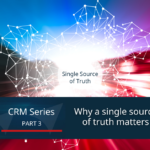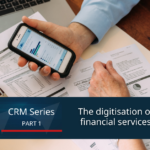Summary
This article, the second one from our Sales and Distribution Digitisation Series, looks at the reality of working with ineffective CRMs for many sales and distribution teams in financial services. It summarises the harm ineffective systems cause to sales and marketing efforts and suggests the solution:
This article at a glance
- Common complaints of ineffective CRMs from the frontline.
- The immediate and long-term costs of poor CRM software.
- What good looks like.
- The dawn of marketing automation software and its impact on marketing and sales.
Is your “CRM” a glorified “Rolodex”?
Customer Relationship Management or/ Customer Lifecycle Management and marketing automation systems aren’t new, but examples of systems that live up to their original promises are few and far between. Many distribution teams feel they are “just a glorified “Rolodex” or “a tool to beat sales teams with” and, in some cases, add significant inefficiencies to the process, hindering customer service delivery. To be blunt, a sales and marketing CRM can do more harm than good if it is not fit for purpose.
Based on our experience of working with many financial service providers, common CRM complaints include:
- Inefficiency and lack of integration: The system does little to help streamline pain points in the operational processes (e.g. automated document sending and management, client suitability assessments and related reporting, appointment booking and management, integration with email/calendars and other office automation software).
- Little focus on customer needs: They don’t add anything to customer interactions, whether failing to pre-populate documentation, provide valuable customer insights or histories, provide discussion prompts or streamline or automate the communication process.
- Inflexible: The processes and software architecture are rigid and aren’t able to adapt to changing user or customer needs.
- Costly: The systems are costly to implement and maintain, requiring IT resource for even minor changes.
A poorly designed system’s immediate and long-term costs can be very high, either directly linked to lost sales or hidden in more difficult-to-measure metrics such as customer loyalty and brand equity. These costs can be summarised in the following way:
• Lost opportunities: From failing to identify and convert opportunities to actively preventing sales and negatively impacting customer service.
• Process efficiency: Failing to deliver promised efficiency savings or introducing further cost through the added process steps and/or bureaucracy.
• Poor user adoption: Poorly designed systems will be viewed as an imposed overhead leading to workarounds.
• Poor customer satisfaction: Cumbersome processes and poorly designed interactions with content are likely to frustrate customers, affecting customer satisfaction and brand advocacy and loyalty.
• Failure to address and evidence the core duty of care: Poor management of customer data and interactions makes it less likely firms can truly understand customer needs and service them appropriately and even less likely that they can evidence this duty should regulators require it.
What good can look like
While the cost of a poorly designed CRM system is high, a well-designed system can add many benefits to your distribution activities and interactions with clients. And a well-designed system will streamline interactions with prospects and clients, making the lives of advisers and other operations staff easier by building a rich understanding of prospects and clients across the full customer lifecycle. These benefits increase dramatically when viewed alongside an integrated marketing automation system. A good CRM solution will typically have the following characteristics:
- Industry-focused: Core processes built for the financial advice/pensions and investments market, not generic retail processes.
- User-focused: A simple, intuitive system that helps sales and distribution teams collaborate and do their jobs more effectively.
- Simplicity: Processes built with usability and simplicity at the forefront save sales teams time and enable more time to be spent working with prospects and clients.
- Automation: Automation of routine tasks such as document production and delivery, follow-up appointment booking, and pre-population of data streamlines administration and drives efficiency.
- Software integration: Integration with other core systems, including office automation tools, client modelling tools and platforms also help drive workforce efficiency.
- Flexibility: End-user configurable journeys that can grow and adapt to business change quickly, in a controlled manner, and with minimal cost
- Segmentation: Dynamic customer segmentation and micro-segmentation.
- Insight: Granular data capture to gain deeper customer insights and insightful and actionable customer reporting.
- Efficient workflows: Simple work queue routing and management supported by real-time operational and performance MI to optimise overall capacity management.
- Customer insight: A 360 view of the customer across the entire lifecycle enables better customer understanding, direct conversations and the ability to address long-term customer needs.
The emergence of marketing automation software
As one of the major complaints is the visibility of client communication and the poor quality and frequency of communication, marketing automation software should be considered as a key component of a well-designed CRM.
An integrated marketing automation system will allow you to use prospect and customer data to improve communications, resulting in an improved customer experience. It also enables a view of contacts across the entire buying cycle, bringing sales and marketing closer than ever before and having the two-functions cooperate to deliver effective and salient customer communications.
Modern marketing automation software will deliver:
- Integration with the core sales CRM enables a complete end-to-end picture of interactions and the movement of contacts through the entire sales cycle.
- Real-time and dynamic lead scoring that changes as customers interact with content and advisors enables the most effective deployment of your resources and tailored communication delivery.
- A complete 360 view of all interactions prospects and clients have with content and advisors enables evaluation of marketing communications.
- Focused content delivery tailored to the buyer journey ensures the most appropriate and relevant marketing and sales content is delivered to prospects and clients.
- Automated campaigns and customer interactions across a range of channels are designed around the buyer journey and feedback real-time performance reports.
- Dynamic website integration, tracking and retargeting to facilitate a holistic approach to marketing automation and digital marketing delivery.
- Automation of the management of seminars and events ensures effective participant tracking and more appropriate follow-up actions.
With digital marketing and sales communications working in greater synergy, the opportunities for improved customer experience are boundless with the right system integration. And for many sales and distribution teams, this kind of software would revolutionise how they work, benefiting the IFA and the provider and, most importantly, improving the experience for the customer.
However, activating and managing such change can be challenging without the correct counsel. And CRM implementation doesn’t come without its challenges, hence the need for expertise and strong leadership for the project’s full duration.
That being said, the benefits of embarking on a bold CRM project are plentiful, and its digital nature lends itself to measurable outcomes and tangible ROI. Helping to minimise perceived risk and internal barriers to change from the get-go.
For more information on digital transformation and change management, visit Hesmur.com
Related articles:
CRM Series article 1: CRM is a central component to successful digitisation in financial services
CRM Series article 2: 5 reasons Dynamics 365 is a good CRM solution for wealth and pension providers and distributors in 2023
CRM Series article 3: Why a single source of truth matters to financial service providers
Steps to digitising sales and distribution in pensions, investments and wealth
Contact us
Call: +442045742661
email: info@hesmur.com
Co-authored by Jim C Smith and Christopher Hess

























